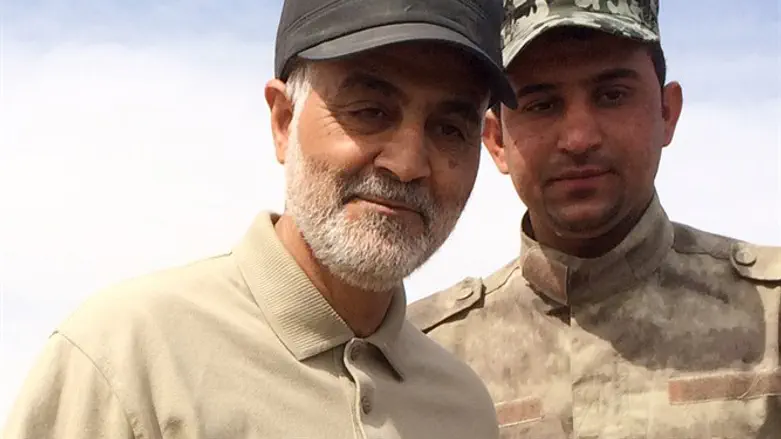
The Israeli security cabinet again convened on Sunday to address the very complicated security situation of the Jewish state.
“We are in a very sensitive and volatile security period on several fronts – north, east and south,” caretaker Prime Minister Binyamin Netanyahu said prior to the meeting.
“We will continue to take action on all fronts for the security of the State of Israel, both openly and covertly, on land, sea, and in the air,” the Israeli PM added a day after the Iranian proxy Islamic Jihad suddenly lobbed 10 rockets on the Israeli town of Sderot.
The coordinated rocket attack came out of the blue and was most likely ordered by Qassem Soleimani the commander of the Quds Force of the Iranian Revolutionary Guards Corps, the organization tasked with exporting the Islamic Revolution.
Soleimani wants his Palestinian Arab clients to continue the war of attrition which effectively started in March 2018 when Hamas launched the weekly orgies of violence along the border with Israel in Gaza under the name “Great March of Return”.
Israel held Hamas, which also has been turned into an Iranian proxy receiving $30 million per month from the regime in Tehran, responsible for the rocket barrage.
Shortly after the Iron Dome anti-rocket shield neutralized all but one rocket IAF warplanes bombed Hamas' military facilities in Gaza.
After the four-hour-long security cabinet meeting the consensus was that the Israeli army must concentrate on the various threats emanating from the north where Iran is continuing its effort to entrench itself on the Golan Heights, the Lebanese front, and Iraq where Iran has created a new base that will be used in a future war against Israel.
The Israeli military has reportedly taken action against Iran’s effort to turn Iraq into new front against Israel and repeatedly prevented the delivery of ballistic missiles and other advanced weaponry to the al-Hashd al-Sha’abi umbrella organization of predominantly Shiite militias in eastern Iraq.
The current popular unrest in Iraq is now threatening Iran’s agenda for the majority Shiite country which is part of what Soleimani calls the “territory of resistance” which Iran expanded from “2,000 square kilometers in southern Lebanon to a territory of half a million square kilometers,” according to the Quds Force commander.
Soleimani has directly intervened in the crisis and reportedly told the Iraqi government to use snipers to quell the demonstrations which started in the first week of October.
More than 250 Iraqi’s were subsequently killed the majority of them by gas canisters and snipers while more than 7.000 others were injured.
The Iranian regime accuses the US, Israel and Saudi Arabia of orchestrating the public unrest in both Lebanon and Iraq and demands an end to the demonstrations which are supported by Ayatollah Ali Sistani the Iraqi leader of the Shiite world community.
Sistani is already for years at odds with Iranian Supreme Leader Ali Khamenei and recently demanded an end to all foreign (read Iranian) interference with Iraqi domestic issues.
Khamenei this weekend again dispatched his close aide Soleimani to Iraq where he requested a rare meeting with Sistani, a clear indication Khamenei realizes that his grand plan for the Middle East is in danger.
Meanwhile, angry Iraqi demonstrators in Karbala, the holy Shiite city stormed the Iranian consulate in the city for the second time this week and reportedly set the building on fire.
Restoring calm in Iraq is very important to Iran because the country was on its way becoming a second Lebanon where Iran's client Hezbollah controls the country’s political and day to day affairs.
Iraq is even more important to Iran than Lebanon not only because it is a very important part of the ‘territory of resistance’ but because of the crucial economic relations between the two former enemies and because of religious considerations by the regime in Tehran.
In the messianic world view of the Iranian mullah’s Iraq’s capital Baghdad is destined to become the capital of the Islamic nation after the return of the Mahdi, the Shiite messiah, at the end of days.
In Lebanon, despite similarities in the nature of the popular unrest - lack of government services, corruption and high unemployment to name a few - the situation is slightly different because Hezbollah is effectively controlling the country.
It was no coincidence that Hezbollah members who initially took part in the protest were ordered to leave the demonstrations after which armed members of the Iranian proxy started to use force against demonstrating Lebanese citizens.
Then there is the southern front which according to Netanyahu today includes Yemen where Iran delivered long-range ballistic missiles to the Ansar Allah militia also referred to as the ‘Houthis’.
“Iran wants to develop precision-guided missiles that can hit any target in Israel within five to ten meters,” Netanyahu said after a meeting with a high-level US delegation in Jerusalem on October 28.
“Iran hopes to use Iran, Iraq, Syria, Lebanon, and Yemen as bases to attack Israel with statistical missiles and precision-guided missiles. That is a great, great danger,” the Israeli PM added.
Israel’s activity against Iran on all fronts has not ended and will continue a well-informed Israeli source toldIsrael Hayom the country’s leading paper.
“We will continue to take action on all fronts for the security of the State of Israel, both openly and covertly, on land, sea, and in the air,” Netanyahu made clear before the rare third security meeting in one month time.
It could be that the Israeli leader is aware of preparations by Iran to divert attention in both Lebanon and Iraq by launching an attack on the Jewish state similar to the one that disrupted Saudi Arabia’s oil production temporarily after a well prepared and coordinated Iranian cruise missile and drone attack on the Kingdom at the beginning of September.